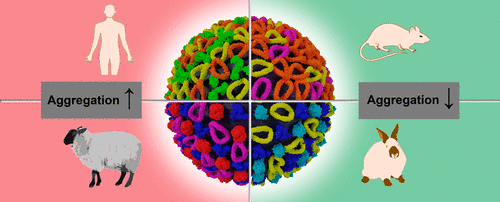当前位置:
X-MOL 学术
›
Biomacromolecules
›
论文详情
Our official English website, www.x-mol.net, welcomes your feedback! (Note: you will need to create a separate account there.)
The Transferability from Animal Models to Humans: Challenges Regarding Aggregation and Protein Corona Formation of Nanoparticles
Biomacromolecules ( IF 6.2 ) Pub Date : 2018-01-12 00:00:00 , DOI: 10.1021/acs.biomac.7b01472 Laura K. Müller 1 , Johanna Simon 1 , Christine Rosenauer 1 , Volker Mailänder 1, 2 , Svenja Morsbach 1 , Katharina Landfester 1
Biomacromolecules ( IF 6.2 ) Pub Date : 2018-01-12 00:00:00 , DOI: 10.1021/acs.biomac.7b01472 Laura K. Müller 1 , Johanna Simon 1 , Christine Rosenauer 1 , Volker Mailänder 1, 2 , Svenja Morsbach 1 , Katharina Landfester 1
Affiliation

|
Nanomaterials are interesting candidates for applications in medicine as drug delivery or diagnostic agents. For safe application, they have to be evaluated in in vitro and in vivo models to finally be translated to human clinical trials. However, often those transfer processes fail, and it is not completely understood whether in vitro models leading to these animal models can reliably be compared to the situation in humans. In particular, the interaction of nanomaterials with components from different blood plasma sources is difficult to compare, and the outcomes of those interactions with respect to body distribution and cell uptake are unclear. Therefore, we investigated the interactions of differently functionalized polymeric and inorganic nanoparticles with human, mouse, rabbit, and sheep plasma. The focus was put on the determination of aggregation events of the nanoparticles occurring in concentrated plasma and the correlation with the respectively formed protein coronas. Both the stability in plasma as well as the types of adsorbed proteins were found to strongly depend on the plasma source. Thus, we suggest evaluating the potential use of nanocarriers always in the plasma source of the chosen animal model for in vitro studies as well as in human plasma to pin down differences and eventually enable transfer into clinical trials in humans.
中文翻译:

从动物模型到人类的转移性:关于纳米粒子的聚集和蛋白质电晕形成的挑战
纳米材料是在医学中用作药物递送或诊断剂的有趣候选物。为了安全应用,必须在体外和体内模型中对其进行评估,以最终将其转化为人类临床试验。然而,这些转移过程常常失败,并且尚不能完全理解导致这些动物模型的体外模型是否可以与人类的状况可靠地比较。特别是,纳米材料与来自不同血浆来源的成分之间的相互作用很难进行比较,而且这些相互作用在人体分布和细胞摄取方面的结果尚不清楚。因此,我们研究了功能不同的聚合物和无机纳米粒子与人,小鼠,兔和绵羊血浆的相互作用。重点放在确定浓缩血浆中发生的纳米粒子的聚集事件以及与分别形成的蛋白质电晕的相关性上。发现血浆中的稳定性以及吸附蛋白的类型都强烈依赖于血浆来源。因此,我们建议评估总是在所选动物模型的血浆来源中进行纳米研究以及在人血浆中评估纳米载体的潜在用途,以缩小差异,并最终使其能够在人体中进行临床试验。
更新日期:2018-01-12
中文翻译:

从动物模型到人类的转移性:关于纳米粒子的聚集和蛋白质电晕形成的挑战
纳米材料是在医学中用作药物递送或诊断剂的有趣候选物。为了安全应用,必须在体外和体内模型中对其进行评估,以最终将其转化为人类临床试验。然而,这些转移过程常常失败,并且尚不能完全理解导致这些动物模型的体外模型是否可以与人类的状况可靠地比较。特别是,纳米材料与来自不同血浆来源的成分之间的相互作用很难进行比较,而且这些相互作用在人体分布和细胞摄取方面的结果尚不清楚。因此,我们研究了功能不同的聚合物和无机纳米粒子与人,小鼠,兔和绵羊血浆的相互作用。重点放在确定浓缩血浆中发生的纳米粒子的聚集事件以及与分别形成的蛋白质电晕的相关性上。发现血浆中的稳定性以及吸附蛋白的类型都强烈依赖于血浆来源。因此,我们建议评估总是在所选动物模型的血浆来源中进行纳米研究以及在人血浆中评估纳米载体的潜在用途,以缩小差异,并最终使其能够在人体中进行临床试验。


























 京公网安备 11010802027423号
京公网安备 11010802027423号